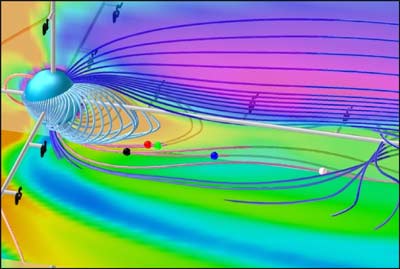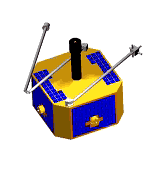 |
The Earth's magnetic field is swept into a long tail by the solar wind. Five satellites that will study the phenomena are shown as colored balls. (Jimmy Raeder, UCLA) |
NASA funds $173 million auroral satellite mission
BERKELEY – NASA has awarded the University of California, Berkeley, a $173 million contract to build and operate a fleet of five satellites to pinpoint the event in Earth's magnetic neighborhood that triggers violent but colorful eruptions in the Northern and Southern lights.
The aurora borealis and aurora australis are shimmering light shows that brighten the polar nights, generated by showers of electrons descending along magnetic field lines onto the poles. These high-speed electrons spark colored lights as they hit the atmosphere, much like a color TV lights up when an electron beam hits the phosphorescent screen.
 Video: the aurora borealis and the satellites that will study the phenomena |
Though geomagnetic storms generated by outbursts of solar wind often create spectacular light shows, a totally distinct process creates substorms that erupt and wane over periods of 3-4 hours. Despite numerous spacecraft in orbit studying the Earth's magnetosphere and space weather, they've never been able to pinpoint where in the magnetosphere the energy of the solar wind transforms explosively into the electron currents that produce auroral eruptions.
"This question hasn't been resolved so far because the process is so quick - the energization starts in space tens to hundreds of thousands of miles away, and 30 seconds later, we see the particles coming in the aurora. The whole night-side polar sky lights up within minutes in a global energization called a substorm," said Vassilis Angelopoulos, a research physicist at UC Berkeley's Space Sciences Laboratory who will lead the project. Called THEMIS, for the Time History of Events and Macroscale Interactions during Substorms, the mission is part of NASA's Medium-class Explorer (MIDEX) program.
"Substorm processes are fundamental to our understanding of space weather and how it affects satellites and humans in space, as well as our understanding of fundamental physical processes of plasma systems," he said. "Understanding substorms is key to predicting space weather, but these processes occur whenever a magnetized wind passes by a magnetized body, such as Mercury or Jupiter."
Angelopoulos hopes the satellite fleet, to be launched in the summer of 2006, will quickly confirm one of two hypotheses about the location of the event causing auroral eruptions.
"We now have two distinct, mutually exclusive hypotheses proposed to explain how and where substorms start, which has resulted in the field diverging in two different directions," he said. "We need to resolve it to make progress."
The project is a large collaboration involving researchers from NASA, four U.S. universities and seven foreign nations, some of whom have been studying the substorm problem for more than 30 years.
"This is probably the oldest and most important problem to solve in the field, and that is why a very large international magnetospheric community is behind it," Angelopoulos said. Team members include scientists from Germany, Austria, France, Canada, Netherlands, Japan and Russia, as well as investigators from UCLA, the University of Colorado in Boulder, Johns Hopkins University and NASA Goddard Space Flight Center.
THEMIS also is the name of the Greek goddess of impartial justice, often depicted in courthouses as "blind justice." The name is a reminder that the mission will judge impartially the two competing theories, Angelopoulos said.
The sun is the source of Earth's magnetic weather, with coronal mass ejections and other violent explosions propelling pulses of ionized plasma - ionized atoms and electrons intertwined with electric and magnetic fields - through the solar system. When these pulses hit the Earth's magnetic field, they distort the field and create a downstream tail like a windsock, Angelopoulos said.
Solar wind energy is stored in the long tail and released unpredictably in bursts of accelerated particles and electron currents. These bursts of energy, occurring somewhere along the equatorial plane of earth's night side, propagate along magnetic field lines to the two poles, generating simultaneous auroras.
Apart from the beautiful light show, substorms also excite a large portion the Earth's ionosphere, interfering with radio signals bouncing off this layer and with radio signals between Earth and orbiting satellites.
"To see this rapid event and to tell where exactly the energy gets released, you need multiple spacecraft aligned along the sun-Earth line," Angelopoulos said. "So, we will align five little probes along the sun-Earth line back on the night side, and they will track that motion of plasma from one probe to the other and tell us where it starts and how it evolves. We'll have our ducks in a row, so to speak."
The probes, to be launched from Cape Canaveral aboard a single Delta II rocket, like the Iridium satellites, will be inserted into equatorial orbits that bring them in alignment every four days for about 15 hours. Over the mission's two-year lifetime, Angelopoulos expects the probes to be perfectly aligned with the Northern hemisphere often enough to catch some 30 substorms, though the first few should answer the team's major scientific question.
Many other questions remain, however. The solar wind constantly presses on the Earth's magnetosphere, creating magnetospheric storms on both the day and night sides. For unknown reasons, storms with embedded substorms create more space weather phenomena and more auroral activity.
"Essentially the aurora is a picture of what happens out in space, and the big question is: Why does it erupt abruptly? Why doesn't it go on at some low level all the time, instead of waxing and waning?" he said. "Substorms appear to be critical - they represent some fundamental means by which the solar wind energy gets processed. Our goal is to understand the physics, onset and evolution of substorms, which is tantamount to understanding why auroras erupt."
The two major hypotheses about the origin of substorms and auroras pinpoint two distinct regions: the area between 25 and 30 Earth radii - half the distance to the moon - where magnetic reconnection takes place; and a closer region, at 10 Earth radii, where current disruption takes place. The region of magnetic reconnection is where anti-parallel magnetic field lines break, loop back and reconnect, snapping like rubber bands and flinging out particles in the process. Current disruption refers to a sudden arcing from an ion current that normally runs across the magnetotail. The arcing current abruptly shoots off along the magnetic field lines toward the poles.
The probes bracket these areas and will be able to tell whether the burst of energy starts from the region of magnetic reconnection or from the region of current disruption.
Aside from the five probes - two in identical one-day orbits, a third in a two-day orbit, a fourth in a four-day orbit, and one spare - the project will equip 20 ground stations throughout Northern Canada and Alaska with automated, all-sky cameras to provide a composite image of the aurora. This way, the aurora can be correlated with events in the magnetosphere.
The probes, weighing about 100 kilograms (220 pounds) when loaded with fuel, each will carry five instruments: a low-frequency magnetic field detector built by German and Austrian collaborators; a high-frequency magnetic field detector built in France; and instruments built at UC Berkeley to measure thermal and super-thermal ions and electrons, and the electric field.
The five probes will be controlled from UC Berkeley's Space Sciences Laboratory, with data downloaded via a radio dish in the Berkeley hills currently used by the RHESSI satellite. Remote data from the northern ground stations will be relayed to the lab by a Canadian satellite service, VSAT.
The spacecraft will be built by Swales Aerospace, Inc., of Beltsville, Md., a firm with recent experience building NASA's FUSE and EO-1 spacecraft. Swales engineers worked closely with Space Sciences Laboratory engineers and scientists to define a robust and cost-effective plan to build five satellites in a short period time.
"What excites our SSL and Swales engineers about this is that NASA has entrusted them with the first scientific Constellation. It is a big honor, and we are ready to live up to the task," Angelopoulos said. NASA's Constellation missions, planned for the middle of the next decade, involve swarms of some 30 small spacecraft scattered around the Earth to answer many outstanding questions - including the origin of auroral substorms - regarding the magnetosphere and the aurora.
THEMIS, the fourth mission funded by NASA's MIDEX program, was chosen from among 31 MIDEX proposals originally submitted to NASA in October 2001. Five were selected in April 2002 for detailed feasibility studies, with THEMIS the first to be given the final go-ahead.
"The Explorer program allows the science community to identify the most compelling science questions and then design the most effective mission to answer those questions," said Edward Weiler, associate administrator for space science at NASA headquarters in Washington, D.C.
 The aurora borealis |

